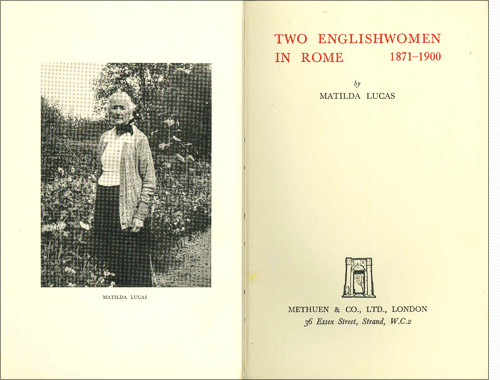|
|
 |
|
| Matilda Lucas Two Englishwomen in Rome 1871-1900, Londra 1938 |
|
|
Seguire le rigide regole del protocollo sociale britannico era arduo per un artista italiano, specie se indigente, come spesso lo era. I mercanti potevano importare le loro opere in Gran Bretagna, ma gli artisti stessi avevano bisogno di appoggi particolari, che in molti casi nascevano da un incontro artistico in Italia.
Spesso queste utili amicizie scaturivano da simpatie professionali: John Sargent, per esempio, assecondava Antonio Mancini nella ricerca di commissioni oltremanica perché ne ammirava profondamente l’abilità.
Il più delle volte, poi, i mecenati inglesi erano anche pittori dilettanti, a cui gli artisti italiani davano lezioni. I casi documentati sono diversi.
Nino Costa trovò in George Howard, un artista ricettivo alle sue teorie artistiche, oltre a essere un protettore, che facilitava la sua fortuna tra collezionisti e gallerie. Prima di sbarcare a Londra nel 1865, Antonio Fontanesi era stato maestro di alcune giovani inglesi di buona famiglia in Svizzera, che senz’altro lo aiutavano in patria. Alessandro Castelli fu probabilmente preso in simpatia dall’ambasciatore Sir Augustus Paget perché la moglie, Lady Walburga, era pittrice. Giovanni Boldini, già insegnante di Isabella Falconer a Pistoia, si è valso dell’amicizia del pittore dilettante Maggiore Cornwallis-West, per potersi promuovere nell’alta società inglese. Telemaco Signorini dava lezioni a Blanche Strahan, moglie di Arthur Lemon, e Vincenzo Cabianca trovò un seguace nella persona dello scrittore Edwin Bale. Daniele Ranzoni incontrò Edward Medleycott in villeggiatura a villa Troubetzkoy sul Lago Maggiore e senz’altro insegnava ai suoi figli pittori, Mervyn Bradford e Hubert James: proprio da questo primo contatto nacque l’invito a recarsi in Inghilterra nel 1877. Giuseppe Raggio e Onorato Carlandi, invece, a Roma davano lezioni ad alcune benestanti pittrici inglesi, che poi seguirono le loro sorti in Gran Bretagna.
Proprio grazie alla sua collaborazione in un collegio per pittrici inglesi, fondato a Roma nel 1878, Michele Cammarano riuscì a esporre Il covo dei briganti alla Lady Artists’ Gallery a Londra l’anno seguente.
Utilissime erano le amicizie tra artisti residenti in Italia e artisti, stranieri o italiani, residenti in Gran Bretagna. Fontanesi sfruttò lo studio dello scultore piemontese Carlo Marochetti in Onslow Square a Londra, come Boldini quello del Maggiore Cornwallis-West a Hyde Park. A Edimburgo, Signorini fu ospitato da Felice Giordano, sposatosi con una scozzese. Per vantaggiarsi nel difficile circuito artistico-sociale, Cecioni si avvalse di Joseph Middleton Jopling, De Nittis di James Tissot.
Altre reti di conoscenze che favorivano la fortuna degli artisti italiani in Gran Bretagna, si svilupparono all’interno delle colonie anglo-americane di Firenze, Roma e Venezia, dove l’artista italiano diventò presto “maestro”, “professore” o “cavaliere”: non a caso, la Società Artistica di Firenze fu fondata nel 1874 da Robert Spranger, un pittore inglese.
|
|
|
The rules of British social protocol were difficult for an Italian artist, especially if indigent, as he often was.
Dealers were able to import their goods easily into Great Britain, but the artists themselves needed that special support that in many cases originated in an artistic encounter in Italy. Often these relationships were fostered by reciprocal esteem: John Singer Sargent, for example, befriended Antonio Mancini because he deeply admired his professional ability.
Often, the visiting English patrons were amateur painters themselves, to whom the Italians gave lessons. There are many cases of this happening.
Nino Costa found in George Howard not only protection, which facilitated his fortune amongst collectors and galleies, but also a person receptive to his artistic theories. Before embarking for London in 1865, Antonio Fontanesi had acted as teacher to some well-to-do English ladies in Switzerland, who then no doubt assisted him in Britain. Alessandro Castelli certainly earned the sympathy of the British Ambassador Sir Augustus Paget, because his wife, Lady Walburga, was a painter. Giovanni Boldini, formerly teacher to Isabella Falconer in Pistoia, cultivated the friendship of the amateur painter Major Cornwallis-West in London, possibly attracted by his beautiful American wife, thus enjoying promotion in British social circles. Telemaco Signorini gave lessons to Blanche Strahan, future wife of the artist Arthur Lemon, and Vincenzo Cabianca found a pupil in the writer Edwin Bale. Daniele Ranzoni met Edward Medleycott when the family were holidaying at the Villa Troubetzkoy on Lake Maggiore, and it was probably through teaching his sons Mervyn Bradford and Hubert James, that Ranzoni received an invitation to visit Britain in 1877.
In Rome, Giuseppe Raggio and Onorato Carlandi held painting classes for a number of English lady artists of means, like Anne and Matilda Lucas, who then followed their fortune in Britain. It was here in Rome, too, that a college for female English artists was founded in 1878, thanks to which Michele Cammarano was able to exhibit Il covo dei briganti at the Lady Artists’ Gallery in London the following year.
Useful friendships formed between artists resident in Italy and artists, whether Italian or English, resident in Britain. Fontanesi availed himself of the studio in London of the Piedmontese sculptor Carlo Marochetti in Onslow Square, as did Boldini of the atelier of Major Cornwallis-West in Hyde Park. To further his introduction to the difficult social-artistic milieu, Cecioni relied on Joseph Middleton Jopling, as did De Nittis with James Tissot.
Other networks useful for making acquaintances and acquiring information helpful to an Italian artist in Great Britain, developed within the Anglo-American colonies in Florence, Rome and Venice: there he soon became distinguished as “maestro”, “professore”or “cavaliere”. Not by chance, Robert Spranger, an English painter, founded the Società Artistica in Florence in 1874.
|
|
|
|
|
|